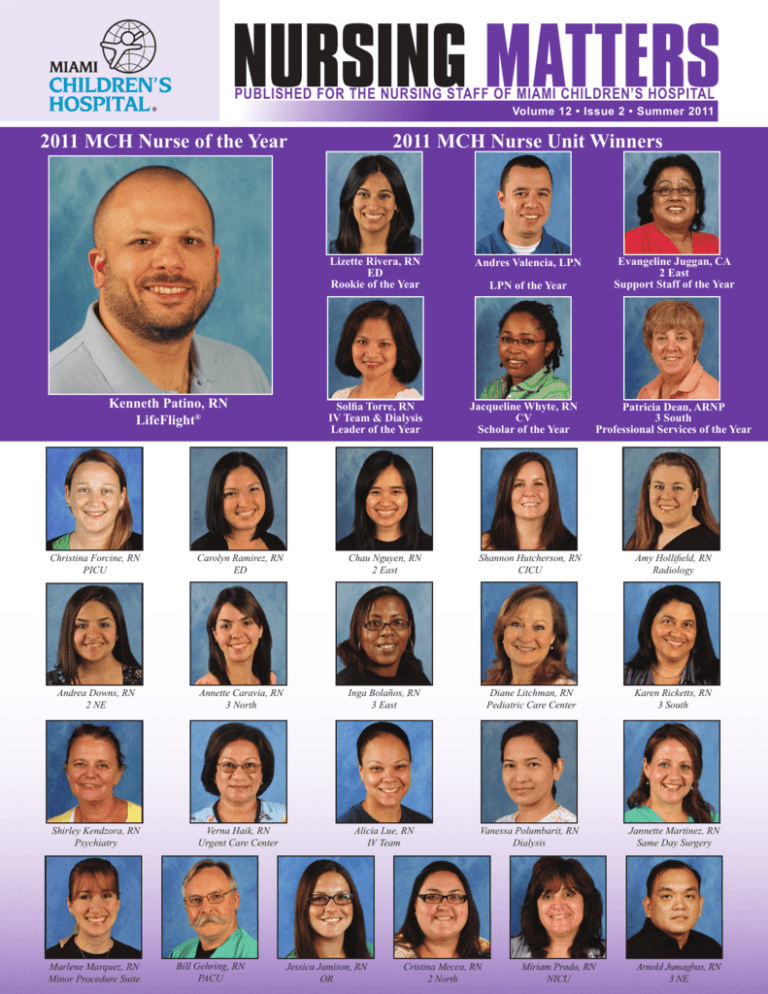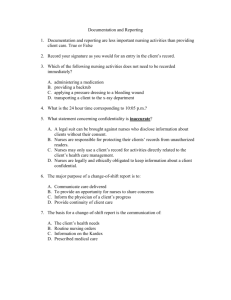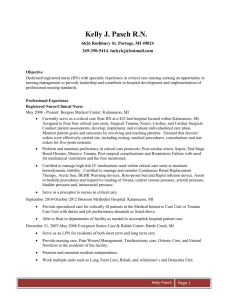nursing matters - Nicklaus Children's Hospital
advertisement

NURSING MATTERS PUBLISHED FOR THE NURSING STAFF OF MIAMI CHILDREN’S HOSPITAL Volume 12 • Issue 2 • Summer 2011 2011 MCH Nurse of the Year 2011 MCH Nurse Unit Winners Lizette Rivera, RN ED Rookie of the Year Kenneth Patino, RN LifeFlight® Solfia Torre, RN IV Team & Dialysis Leader of the Year Evangeline Juggan, CA 2 East Support Staff of the Year Andres Valencia, LPN LPN of the Year Jacqueline Whyte, RN CV Scholar of the Year Patricia Dean, ARNP 3 South Professional Services of the Year Christina Forcine, RN PICU Carolyn Ramirez, RN ED Chau Nguyen, RN 2 East Shannon Hutcherson, RN CICU Amy Hollifield, RN Radiology Andrea Downs, RN 2 NE Annette Caravia, RN 3 North Inga Bolaños, RN 3 East Diane Litchman, RN Pediatric Care Center Karen Ricketts, RN 3 South Alicia Lue, RN IV Team Vanessa Polumbarit, RN Dialysis Jannette Martinez, RN Same Day Surgery Shirley Kendzora, RN Psychiatry Marlene Marquez, RN Minor Procedure Suite Verna Haik, RN Urgent Care Center Bill Gehring, RN PACU Jessica Jamison, RN OR Cristina Mecca, RN 2 North Miriam Prado, RN NICU Arnold Jumagbas, RN 3 NE From the Desk of Jackie Gonzalez Dear Nursing Team: Each and every day of the year, I am proud of the compassion, creativity and care excellence of our MCH nursing team. So it is always with special pleasure each year that I embrace Nurses Week. It’s a great time to pause in the midst of the good work that we do and to celebrate all that it means to be a nurse here at this great hospital. Pediatric nurses are a special breed. Each day we wear many hats: expert care practitioner, compassionate collaborator working with parents to ensure the child’s needs are met, and friend and advocate for the children we serve. You make it look easy. It takes a unique blend of skill and spirit to do what you do each day. During Nurses Week we were pleased to recognize you and all that you do to serve the children in our care. I am delighted to acknowledge all of the nurses honored during the week for their care excellence. Congratulations to all for the excellent work and collaborative spirit that has earned you kudos from your colleagues within the nursing team. Among the highlights of Nurses Week was our Magnet Kickoff Celebration, titled “Third Time’s a Charm.” Next May, we will be up for our Magnet designation renewal. We live the Magnet ideals each and every day. It’s now up to us to capture and showcase our excellent clinical leadership practices for ANCC evaluation. Since our last renewal in 2007, the Commission on Magnet has introduced a new conceptual model grouping the 14 Forces of Magnetism into five key components: Transformational Leadership; Structural Empowerment; Exemplary Professional Practice; New Knowledge, Innovations & Improvements; and Empirical Outcomes. You will be hearing more about this new model in the months ahead as we work to prove that the “Third Time” is indeed a charm. I look forward to working with you as we once again demonstrate MCH’s Magnetism. Sincerely, Jackie Gonzalez, ARNP, MSN, NEA-BC, FAAN Senior Vice President / Chief Nursing Officer / Patient Safety Officer 2 NICU Nurses Save the Whales By Jane Larew, RN, NICU I n late May, several pilot whales were stranded at low tide on the shores of Cudjo Key. Although some of them perished, those that were healthy enough to be on their own were released into the deep waters of the Atlantic Ocean. Those that were not healthy were transferred to the Marine Mammal Conservancy, located in Key Largo, for medical care and rehabilitation after their ALTE (acute life threatening event). As air breathing mammals accustomed to inhabiting deep waters, their respiratory systems are not capable of handling the pressures exerted by their own weight when stranded on dry land. As the tides rose, they were too weak to maneuver themselves off the beach and salt water and debris was able to enter their the words are familiar, the techniques and skills of the vets and trainers differed tremendously from those with which we are accustomed. They pass NGTs (the size of a garden hose) through rows of razor sharp teeth to hydrate and feed the smallest and sickest of the whales. Nothing about the pilot whale’s care is routine. They are wild creatures in distress being held and touched by different humans every four-hour shift. We are a species they had never encountered before and must seem so alien to them, but they are smart and quick to trust. Some of us have returned to volunteer many times and we see the progress of some but are saddened by the loss of those who were unable to overcome the severe trauma of beaching. Life is fragile on our planet, for us, our families and the children for whom we provide care. There are few certainties in this life. I have felt a deep appreciation for life and, along with the other nurses from NICU, I am touched by our experience with these magnificent creatures. blowholes, causing them to aspirate. They arrived at the “hospital” for treatment and the Marine Mammal Conservancy volunteer group began the arduous task of holding the whales so that they could breathe. The call went out for more volunteers, as each whale required three to four humans to create what amounted to floating hospital beds, and each whale had to be held around the clock. Without the human hands, the whales would sink and aspirate more salt water through their blowholes and into their lungs, only worsening their pneumonia. The pilot whales that were released are being tracked and are very active in deep water once again. The nursing staff in the NICU responded to the call. Megan, our Clinical Coordinator, organized a “field trip” for us. A time was set for 4 a.m. to 8 a.m. to go to Key Largo and lend a helping hand. Although not all of the volunteers were able to attend, those who did go had a once- in-a-lifetime experience. What does it feel like to hold an 800-pound baby whale or a 1,200-pound toddler whale, count its heartbeat and respirations and hold it afloat for four hours at a time? Aside from the weight difference of course, it is remarkably similar to the “touch times” we do in the NICU. Checking heart rate, respirations, giving aerosols, monitoring thermoregulation, providing nutritional feedings, administering meds, aiding with physical therapy to encourage normal movement and ROM as well as drawing labs. Even though 3 Therapeutic Hypothermia for Cardiac Surgery at MCH CV Service Postoperative Re-warming after Cardiac Surgery By David Aguero, CV OR RN I n our pediatric heart surgery service, therapeutic hypothermia is utilized during cardiac surgery to protect the vital organs of patients during cardiopulmonary bypass. Depending upon the complexity of the procedure – which could be as complex as a Norwood procedure or as simple as an atrial septal defect repair – the patient’s body temperature is decreased. The decrease might range from 28 degrees Celsius for a simple procedure to 17 degrees Celsius for a more complex procedure. The lower temperature prevents damage to vital organs and tissues. During the procedure, organs are continuously monitored, especially the brain, through use of a head oximeter probes (somanetics). The perfusion team also obtains blood gases at regular intervals to check all critical levels especially PO2, CO2, K, Ca, glucose and more. It has been proven over more than 15 years that therapeutic hypothermia has benefited many of the pediatric heart surgery patients in our cardiac service. Our MCH cardiovascular surgery team uses air warmers, water heater pads and IV fluid warmers to re-warm the patients after cardiac surgery. The warm protocol is to keep the patient covered with warm blankets upon transfer to CICU to maintain the patient’s optimum temperature post operatively. Depending on the complexity of the case and the severity of patient diagnosis, the aim is to keep a body temperature above 34Cº-35Cº to prevent cardiac arrhythmias or other complications post operatively. Efficacy of postoperative re-warming and maintenance of normal temperature is a team effort that begins in the OR and continues in postoperative care for successful recovery of patients. Nursing Matters is produced quarterly by and for the nursing staff of Miami Children’s Hospital in collaboration with the Marketing department Jackie Gonzalez, ARNP, MSN, NEA-BC, FAAN Senior Vice President, Chief Nursing Officer, Patient Safety Officer Marcia Diaz de Villegas Director of Marketing and Public Relations Marketing Editor: Rachel Perry Nursing editors: Joy Ortiz, RN, CCRN Monica Brown, RN, MSN, CPN Contributing Writers: The nursing staff of Miami Children’s Hospital Layout: Roberto Perez Photography: Edgar Estrada, Steven Llanes, Juan Carlos Rabionet 1701-RDP072011




